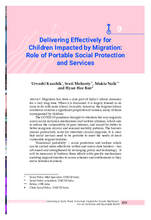Abstract:
Migration has been a core part of India’s labour economy for a very long time. When it is discussed, it is largely framed as an issue to do with male labour. In reality, however, the migrant labour workforce contains a significant proportion of women, many of them accompanied by children.
The COVID-19 pandemic brought to attention the way migrants access social inclusion mechanisms and welfare schemes, which aim to reduce the vulnerability of poor laborers, and would do better to better recognize circular and seasonal mobility patterns. The barriers remain particularly acute for interstate circular migrants. It is clear that social services need to be portable to meet the needs of most vulnerable migrant families. ‘Functional portability’ – social protection and welfare which can be carried more effectively within and across state borders – has advanced and strengthened by leveraging policy and technology. It will be necessary to buttress these efforts with specific mechanisms enabling migrant families to access schemes and entitlements as they move between locations.
It is crucial that benefits become more portable for migrants, whether they are moving within or across state borders. Factors affecting this include the design, implementation and delivery processes, and institutional arrangements for the different schemes, whoever is responsible for administering them. The centre-state, rural-urban and source-destination axes all need to be considered. There is a new drive – especially post-pandemic – towards portability and there is a lot to further build on.
This is Chapter 9 of the "Investing in Early Years in Human Capital for Future Resilience: For an Inclusive and Equitable World" book by UNICEF.


